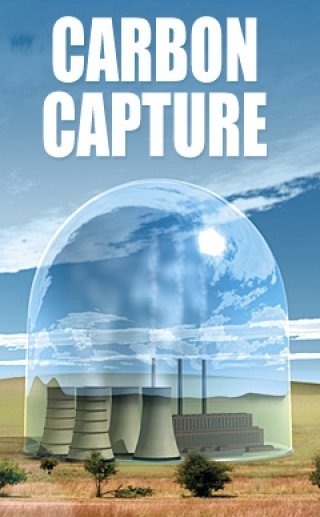Methods for Capturing Carbon Dioxide
Methods for Capturing Carbon Dioxide
| Topics: |
Capturing CO2 is already a standard practice for several industries. For example, natural gas treatment plants and ammonia fertilizer factories separate CO2 from their product streams, but often just vent the CO2 to the atmosphere. Yet not a single large power plant (generating more than 500 MW) currently captures CO2, although several facilities are under construction. [1], [2], [3] The reasons are largely economic: Carbon capture almost doubles a power plant’s construction cost and adds 50% to electricity generation costs. Only with adequate financial incentives does carbon capture become a viable option.
Power plants could capture CO2 either during fuel processing, before combustion, or from the flue gas, after combustion. Capture before combustion is straightforward for integrated gasification combined cycle (IGCC) electric power plants, in which the water– gas shift converter produces a gas stream containing CO2 at relatively high concentrations and pressures. Capture after combustion is easiest for oxy-fuel plants, which combust fuel in pure oxygen and thereby produce flue gas that is nearly pure CO2.
Physical separation, chemical separation, or combinations of the two may remove CO2 from power plant gas streams. Physical methods include cryogenic separations and membrane separations. Cryogenic (low temperature) separation of CO2 from a gas stream is based on differences in the temperatures at which gases condense to a liquid or, in the case of CO2 at normal atmospheric pressure, freeze directly to a solid “dry ice.” In specific, cooling a gas stream to below –88.5°C removes mercury, water, sulfur dioxide, carbon dioxide, and nitrous oxide, yet allows nitrogen and oxygen to pass. In membrane separation, another physical method, transfer of CO2 or H2 depends on differences in partial pressures (concentration multiplied by pressure) between two different streams of gases on each side of a gas permeable membrane .
Chemical methods to remove CO2 include liquid solvents and solid sorbents. Once these substances become fully loaded with CO2, they are isolated from the main gas stream and exposed to higher temperatures or lower pressures to release the CO2 and regenerate their capacity for CO2 removal. Some capture systems based on liquid CO2 scrubbers have achieved above 90% recovery of CO2 in the laboratory, yet none for electric power generation has progressed beyond the pilot plant stage. [4] Solid sorbents are common in the chemical industry and may achieve 90% or higher recoveries of CO2 from the gas streams of industrial processes. Use of solid sorbents in large electric power plants is still unrealized, however. [4]
Oxy-fuel power plants combust coal, syngas, or natural gas in nearly pure O2 rather than normal air (which is 20.94% O2) and produce exhaust gases that are over 95% CO2. Under these circumstances, the challenge shifts from capturing CO2 to extracting O2 from air for the combustion process. Current methods parallel those for CO2 capture (separation across polymer membranes, cryogenic distillation, or adsorption on pressure-swing solid sorbents) and have similar energy requirements.
Once a power plant captures the CO2, the next step is purification and compression. Purification may involve removal of water, sulfur compounds, nitrogen compounds, and trace metals, depending on the fuel source and the processing of the gas stream that is required pre- and post-combustion. Compressing a gas stream to greater than 0.5 MPa and chilling it to –57°C selectively freezes CO2.
[1] IPCC (2005) IPCC Special Report on Carbon Dioxide Capture and Storage prepared by Working Group III of the Intergovernmental Panel on Climate Change, Metz, B., O. H. Davidson, C. de Coninck, M. Loos, and L. A. Meyer, eds. Cambridge University Press, New York.
[2] MIT Study Group (2007) The Future of Coal, Massachusetts Institute of Technology, Cambridge, MA, http://web.mit.edu/coal/The_Future_of_Coal.pdf.
[3] National Energy Technology Laboratory (2007) Fossil Energy Power Plant Desk Reference, U.S. Department of Energy, http://204.154.137.14/energyanalyses/pubs/Cost%20and%20Performance%20Baseline%20for%20Fossil%20Plants%20Desk%20Referen.pdf.
[4] National Energy Technology Laboratory (2007) Carbon Sequestration Program Environmental Reference Document, U.S. Department of Energy, Albany, OR, http://www.netl.doe.gov/technologies/carbon_seq/refshelf/nepa/AA%20-%20Assembled%20Document.pdf.
This is an excerpt from the book Global Climate Change: Convergence of Disciplines by Dr. Arnold J. Bloom and taken from UCVerse of the University of California.
©2010 Sinauer Associates and UC Regents

0 Comments